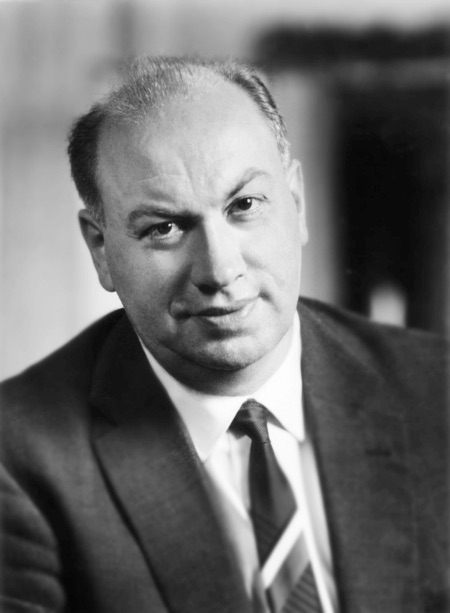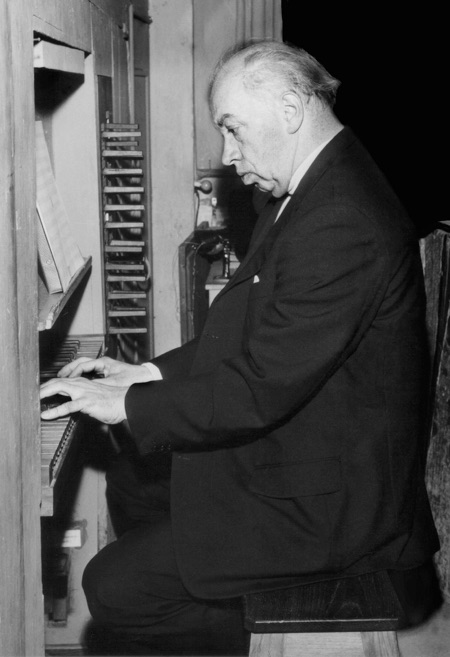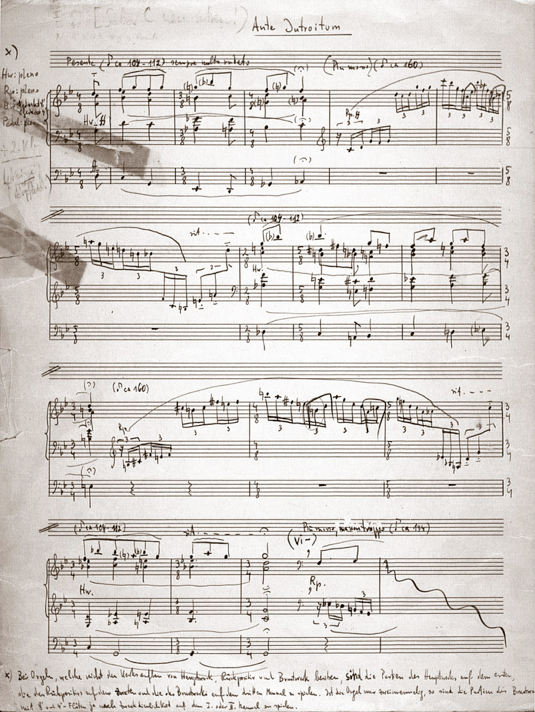
Anton Heiller
(Photo: Madensky)
ANTON HEILLER (1923 – 1979)
Anton Heiller was born in Vienna on September 15, 1923. It is impossible to imagine both the international music life and the music life in Austria – that he has strongly affected – without his composing creativity focussed on sacred music, his interpretational and improvisational skills as an organist, pianist, harpsichordist, and conductor as well as his influence as a pedagogue. The universal artistic personality Anton Heiller was honoured by numerous awards and tributes.
Since childhood the ingenious young musician has been familiar with church music, and the son of the choral director (Regens chori), at that time eleven years of age, spent every free minute on the new organ in the parish church in Dornbach. Anton Heiller completed his studies in incredibly short time and graduated with diplomas in organ and harpsichord from the former “Reichs” Academy of Music in Vienna at the age of 19.
During the last years of war, Heiller’s performing activity as an organist and conductor had enforcedly decreased, but pieces for organ and piano, songs, and the Mass in G Mixolydian mode (1944) from this time became the first milestones in Heiller’s œuvre.
After the war Anton Heiller in an impressive career as a conductor applied himself besides orchestral works mainly to choral works and oratorios, particularly Franz Schmidt’s “Buch mit sieben Siegeln” (“The Book with Seven Seals”). However, Heiller declined honourable offers for a further development of his career as a conductor because in that case he would have had to neglect his organ playing, and “first of all I am devoted to my organ“ (A.H. 1972).
With a hardly countable number of organ concerts all over the world Anton Heiller became an ambassador of Austrian organ art, which he served as both a composer and improviser.
Titles and texts of Anton Heiller’s vocal compositions are mostly of sacral origin, be it masses, motets, anthems, vespers, cantatas, or soli and songs. Furthermore, choir works as adaptations of folk songs or over humorous texts and the ballad “François Villon“ for soloists, chorus and orchestra (1956) testify the variety of the composer’s expressions.

Anton Heiller with his
„first love“
(Photo: Nerio)
Anton Heiller dedicated the main part of his instrumental compositions to the organ, his “first love“, in addition to pieces for orchestra, chamber ensemble or solo instruments such as piano or harpsichord. Peter Planyavsky, one of the prominent students of Anton Heiller, if not the most prominent of all, made the attempt to classify the complete works of his teacher into three creative periods on the basis of his stylistic development (“Zum Orgelschaffen Anton Heillers”. Preface to the Edition of the Partita “Erhalt uns Herr, bei Deinem Wort”, dedicated to P. Planyavsky. – Vienna, Doblinger 1977):
For the time period until approximately 1949 he characterised the style as “predominantly linear, interspersed with canonical and imitative formations, in the free works the arrangement has a high level of formal consistency and symmetry. … tonality still absolutely centre-based, … prefers modal forms without any leading notes. …”. Besides Franz Schmidt, Planyavsky refers to Johann Nepomuk David and Paul Hindemith as “fathers” of the early composition style of Anton Heiller. Partitas, most of them chorale partitas, the two Sonatas, and Prelude and Fugue in A Major date from this era.
Planyavsky describes the second stylistic period within Heiller’s complete works, where he increasingly attended to vocal compositions, as a further development of the “polyphonic tenor” to greater lucidity and maturity. “Because of the still increasing vocal fraction in his themes, imaginary instrumental parts imperceptibly also become singable, and dissonances are no longer developed by the clashing of two voices, but rather by a pressing together in a rubbing way. …”
Furthermore, the unmistakably strong influence of stylistic devices of French origin on harmony, rhythmicity and melody creation in Heiller’s compositions could primarily be traced back to Frank Martin. – From his organ works, the four pieces “In Festo Corporis Christi”, the so called “Corpus Christi Pieces” (1957) would express this new stylistic attitude of Heiller. They are “something like an inscribed liturgical organ piece, as it is requested on the Feast of Corpus Christi with the Gregorian Proprium chants in the Mass. …” In the Postlude, “the new harmony is revealed in its whole brilliance at the beginning; subsequently, there also appear the small structured, quasi merely chant-dependent polyrhythms that will later on dominate the complete first part of the Fantasia super ‘Salve Regina’.”
The most important vocal piece of the second chapter of Anton Heiller’s development as a composer is the “Missa super modos duodecimales” from 1960, an impressive document of his trend towards dodecaphony. (This was the last opus Anton Heiller conducted in the ORF shortly before his death.) The twelve-tone elements or -melodies present in Heiller’s works of this time are harmonised freely or in tonal functions.
In Anton Heiller’s late creation period, the organ works over Gregorian themes are followed by numerous adaptations of Cantus firmi in terms of chants. This third phase of Heiller’s creative organ work is characterised by an “internalisation of the style … a darkening in expression, growing considerably sadder and calmer at the same time”. The only free organ piece of that time is “Jubilatio” (1976).
Since 1945 until his early death in March 25, 1979, Anton Heiller taught on the University (then Academy, afterwards “Hochschule”) of Music and Performing Arts in Vienna: organ (initially also harpsichord) and church composition. 40 students out of more than 120 graduated under the supervision of Anton Heiller.
For Anton Heiller, one of Vienna’s prominent musicians, sacred music was life and fulfilment – most of his works ended with the letters S.D.G. (Soli Deo Gloria).
In 2008 Anton Heiller would have celebrated his 85th birthday.
Helga Michelitsch

„In festo corporis Christi“
(Musiksammlung der Österreichischen Nationalbibliothek)
